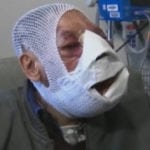 Music
Music  Music
Music  History
History 10 Less Than Jolly Events That Occurred on December 25
 Weird Stuff
Weird Stuff 10 Funny Ways That Researchers Overthink Christmas
 Politics
Politics 10 Political Scandals That Sent Crowds Into the Streets
 Weird Stuff
Weird Stuff Ten Bizarre Facts About The Doge Meme
 Our World
Our World 10 Ways Your Christmas Tree Is More Lit Than You Think
 Movies and TV
Movies and TV The 10 Coolest Stars to Set Sail on The Love Boat
 History
History 10 Things You Didn’t Know About the American National Anthem
 Technology
Technology Top 10 Everyday Tech Buzzwords That Hide a Darker Past
 Humans
Humans 10 Everyday Human Behaviors That Are Actually Survival Instincts
 Music
Music 10 Surprising Origin Stories of Your Favorite Holiday Songs
 History
History 10 Less Than Jolly Events That Occurred on December 25
 Weird Stuff
Weird Stuff 10 Funny Ways That Researchers Overthink Christmas
Who's Behind Listverse?

Jamie Frater
Head Editor
Jamie founded Listverse due to an insatiable desire to share fascinating, obscure, and bizarre facts. He has been a guest speaker on numerous national radio and television stations and is a five time published author.
More About Us Politics
Politics 10 Political Scandals That Sent Crowds Into the Streets
 Weird Stuff
Weird Stuff Ten Bizarre Facts About The Doge Meme
 Our World
Our World 10 Ways Your Christmas Tree Is More Lit Than You Think
 Movies and TV
Movies and TV The 10 Coolest Stars to Set Sail on The Love Boat
 History
History 10 Things You Didn’t Know About the American National Anthem
 Technology
Technology Top 10 Everyday Tech Buzzwords That Hide a Darker Past
 Humans
Humans 10 Everyday Human Behaviors That Are Actually Survival Instincts
10 Strange Stories About The Human Brain
The human brain is an amazing organ. It’s great for whiling away the hours, conferring with the flowers, and solving the most complex problems known to man. At the same time, it’s an extremely mysterious lump of gray matter that can survive the craziest accidents, unlock the secrets of the universe, and turn on us at a moment’s notice. Without a doubt, our little gray cells hold enough secrets and strange stories to fill an entire book . . . or a list, for that matter.
10The Murderer Saved By Brain Scans

John McCluskey wasn’t a pleasant man. After escaping from an Arizona prison, he killed an elderly couple, burned their bodies, and stole their truck. Eventually, McCluskey was recaptured, tried, and found guilty of murder. However, the sentencing phase was a little more difficult. McCluskey’s defense team had employed a unique strategy that left jurors unsure of what they should do. The lawyers had presented them with scans of McCluskey’s brain, and the images were definitely weird.
The PET scans showed 10 areas of McCluskey’s brain that were strangely inactive. On the other hand, 17 areas were working overtime. For example, his amygdala couldn’t interpret danger signals properly and often sent “false alarms” to the rest of the brain, causing him to act impulsively. Usually, the frontal lobe keeps the amygdala’s crazy tendencies under control, but McCluskey’s was deformed and defective, allowing his wilder impulses to reign unchecked. The defense attorneys also noted that his cerebellum was damaged by a stroke, which in turn affected his ability to make plans. Basically, he was a victim of bad biology and unable to commit premeditated murders. The Haas killings had been spontaneous and out of McCluskey’s control.
Despite the prosecution’s counter arguments, the defense team achieved their goal. The jury couldn’t decide whether or not McCluskey should die, which meant that he was sentenced to life without parole. McCluskey’s brain had saved him from walking the green mile. However, the jury’s decision poses several interesting questions. Should abnormal brains be seen as mitigating factors or evidence of dangerous behavior? And where does free will come into this scenario? We’ll let you deliberate for yourself.
9The Strange Journey Of Einstein’s Brain

Albert Einstein was clearly a genius, and many of us have wondered from time to time, “How did his brain work?” Pathologist Thomas Harvey wondered the same thing, and he decided to find out the answer. If he had to break a few rules along the way, so be it.
Before his death in 1955, Einstein stipulated that his remains were to be cremated. The last thing he wanted was mobs of zealous students gathering around his tomb, murmuring “E = mc2” over and over. The only way to keep his corpse from becoming a holy relic was to burn it to a crisp. That meant he wanted his brain fried, too.
However, Thomas Harvey didn’t care. Claiming he had permission of Princeton Hospital—which he didn’t—Harvey plucked out Einstein’s brain during the autopsy. Needless to say, this was a huge no-no. In danger of losing his job, Harvey convinced Einstein’s son to okay the operation, claiming his dad’s brain needed to be studied for science. However, Harvey wasn’t a neuroscientist and didn’t know what he was doing. When hospital officials asked him to hand over the brain, he refused and was fired. His next step was to drive to Philadelphia, where he found a technician to slice Einstein’s brain into over 200 cubes.
Over the next 40 years, the little squares ended up in the weirdest places. Harvey stored them in jars in his basement, where they almost met destruction at the hands of his wife. When Harvey moved to Kansas, he kept the bits in a box under a beer cooler. They were regularly admired by Naked Lunch author William Burroughs, and Harvey once accidentally left them at the house of Einstein’s granddaughter, who wasn’t too pleased.
As for scientific study . . . that didn’t exactly pan out. Harvey mailed pieces of the brain to various researchers, but most neurologists weren’t keen on analyzing Einstein’s brain. The few scientists who did show interest cranked out studies that were mostly inconclusive, derided, or discredited. Disappointed, Harvey eventually returned the brain to Princeton Hospital and died in 2007. Nobody ever tried to steal his brain.
8The Man Who Stuck His Head In A Particle Accelerator

Anatoli Bugorski might be the luckiest scientist of all time. On July 13, 1978, the Soviet researcher was repairing a particle accelerator intimidatingly named the Synchrotron U-70. As he was repairing a faulty piece of equipment, he made a slip-up worthy of Tim “The Tool Man” Taylor. While poking around the machine, Bugorski stuck his head inside the accelerator and straight into the path of a proton beam.
Made out of hydrogen atoms without electrons, proton beams are often used to obliterate cancer cells, but only in carefully controlled doses—just over five grays (“grays” measure absorbed doses of ionizing radiation) will normally turn humans into irradiated toast. When the beam zapped Bugorski, it measured about 2,000 grays. When it exited near the left side of his nose, it blasted out at 3,000.
As it coursed through his skull, the proton beam burned a hole through Bugorski’s brain. While it was painless, he said he was blinded by a flash “brighter than a thousand suns.” After staggering away from the machine, the left side of his face swelled to enormous proportions. Later, the skin near the entry and exit wounds peeled away, and Bugorski lost hearing in his left ear. However, this Soviet survived his mind-blowing experience, perhaps because the proton beam was moving at nearly the speed of light.
Despite his good luck, Bugorski eventually lost every nerve in the left side of his face, becoming partially paralyzed. The proton beam also damaged Bugorski’s mental capabilities, though not as badly as you might expect. Despite his handicap, Bugorski earned a PhD and is still alive today, proving that it takes a lot more than a proton beam to kill a Russian.
7The Artist Who’s Missing A Piece Of His Brain

Jon Sarkin, a 35-year-old chiropractor, was playing golf one day when something weird happened inside his head. One of his blood vessels started moving and eventually pressed against his auditory nerve, causing a deafening case of tinnitus. Hoping to cure the incessant buzzing, Sarkin underwent a strange type of surgery in 1989. His doctor separated the nerve and capillary with a piece of Teflon, but unfortunately, the treatment caused a massive stroke. When Sarkin woke up weeks later, he found he was missing a piece of his brain.
Due to the stroke, doctors had cut a chunk from the left side of Sarkin’s brain, causing a complete personality change. Suddenly, Jon had a burning desire to draw, an urge that totally consumed his life. When he returned to his chiropractic practice, he sketched random pictures between patients, doodling strange shapes, cacti, and odd faces. During dinner, he would stop eating to jot down ideas that were bubbling up in his brain. It turned out that Jon was experiencing an bizarre condition called “sudden artistic output,” which is so rare that doctors have only recorded three cases caused by brain injury.
However, this brain injury would make most starving artists green with envy. In 1993, Sarkin sold eight of his pictures to The New Yorker, quit his business, and opened an art studio. Since then, Jon’s work has appeared in The New York Times and The Boston Globe. His story was purchased by Tom Cruise’s production company, and he was the subject of a book written by a Pulitzer Prize–winning author. If you want to buy one of Jon’s pieces, you’ll have to shell out more than $10,000 per canvas. As far as stroke side effects go, this one is pretty profitable.
6The Man With Almost No Brain

Not only does the brain control every facet of our lives, it constantly works under intense pressure—sometimes quite literally. For example, take the 2003 tale of an unnamed French citizen whose unusual story was published in The Lancet. Since his identity was kept a secret, we’ll call him Jacques.
Jacques was a married man with two kids who worked as a civil servant in Marseille. One day, his left leg felt rather weak, so he visited a local hospital. As the doctors ran through his medical history, they learned that when Jacques was a baby, he’d suffered from hydrocephalus, which is a buildup of liquid inside the brain. The “water” had been drained away, but the doctors decided to take a few scans and see if Jacques’s problem was neurological in nature.
What they found was astonishing. The majority of Jacques’s head was filled with fluid. Normally, the human brain is protected by lateral ventricles, which are structures filled with cerebrospinal fluid that act as a cushion for our little gray cells. Liquid flows through these chambers all the time, but in Jacques’s case, the fluids weren’t draining. Over time, the buildup caused his lateral ventricles to swell so much that his brain had been flattened to a thin sheet. Doctors estimated that his brain mass had been reduced by 50–70 percent, affecting the areas in charge of motion, language, emotion, and, well, everything.
Shockingly, Jacques was fine. While his IQ was only 75, he wasn’t mentally challenged. He held a steady job, raised a family, and didn’t have trouble interacting with others. Over time, his brain had adapted to all that pressure, and even though he had fewer neurons that most, Jacques was still a fully functional human being. And don’t worry, his leg was fine. Once doctors inserted a shunt and drained the fluid, his limb returned to normal. However, his brain is still pretty small, showing that you don’t have to be a genius to work for the government.
5The Mentally Ill Man Who Cured Himself With A Gun

George (whose last name is unknown) was obsessive-compulsive. In fact, his OCD made Howard Hughes’s look mild in comparison. Back in the ‘80s, George was a hardworking Canadian high school student who suddenly developed an irrational fear of germs. He started washing his hands hundreds of times every day and was constantly taking showers. Despite his trips to the local hospital, George couldn’t get his disorder under control, and he was eventually forced to leave school and quit his part-time job.
Finally, in 1983, George decided to take matters into his own impeccably clean hands. Depressed and paralyzed with fear, he told his mother he couldn’t go on anymore. As a sensitive woman who greatly cared for her son, she responded with, “If your life is so wretched, just go and shoot yourself.” And that’s exactly what George did. He grabbed a pistol, stuck it in his mouth, and pulled the trigger.
The bullet tore through his skull and slammed into his left front lobe—the part of his brain responsible for his OCD. Fortunately, George survived, and when he awoke from surgery, he found that his fear of microbes had disappeared along with a chunk of his brain. He’d cured himself with a lobotomy by gunshot. He still had to take medications for depression, but his overwhelming compulsions were gone. And this is where we need to put a little disclaimer: Don’t try this at home.
4The Woman Who Can Trigger Out-Of-Body Experiences

While most associate out-of-body experiences with crazy callers on late-night radio shows, University of Ottawa scientists take the subject a little more seriously. In 2012, an unnamed psychology student, whom we’ll call Reese, told Professors Claude Messier and Andra Smith that she regularly left her body and even that she could actually trigger these events.
Reese claimed she started taking astral trips during preschool when she was supposed to be napping. As she grew older, these “extracorporeal experiences” became a psychic sleep aid, helping her drift off to dreamland. Reese said she’s had several different kinds of episodes, like floating above her “real” body or spinning around like a propeller. While Reese knows she isn’t really moving—she can see her corporeal form lying on the bed or floor—she still feels quite dizzy afterward.
Naturally, Messier and Smith were skeptical, but when they put Reese in an MRI, they noticed some weird stuff happening in her brain. Whenever she triggered an out-of-body experience, they noticed that Reese’s visual cortex—the part responsible for the pictures we see in our minds—was strangely deactivated. In fact, the entire right side of her brain was dormant. However, there was a lot of activity happening in the left side. That’s odd because when we imagine things, both hemispheres are involved. Having said that, a lot of areas on the left side involving “kinesthetic imagery” (the part that helps us understand where we are in relation to our surroundings) were firing away like normal.
Messier and Smith believe Reese is experiencing some sort of hallucination, one that doesn’t affect her in a negative way. It’s like a dream where you’re outside yourself and can watch “you” as a character. The Canadian researchers suspect that perhaps these extracorporeal experiences are a normal part of infancy and some people continue to experience them as they grow older. If there are such people, they probably think their little trips are normal. Reese herself had no clue her waking experiences were unique. “I thought everybody could do that,” she said.
3The Vegetative Patient Who Could Talk To Doctors

Scott Routley was a “vegetable”—at least, that’s what doctors thought. A car accident seriously injured both sides of his brain, and for 12 years, he was completely unresponsive. Unable to speak or track people with his eyes, it seemed that Routley was unaware of his surroundings, and doctors assumed he was lost in limbo. They were wrong.
In 2012, Professor Adrian Owen and postdoctoral fellow Lorina Nacia of the University of Western Ontario decided to run tests on comatose patients like Scott Routley. Curious if some “vegetables” were actually conscious, Owen put Routley in an fMRI and told him to imagine walking through his home. Suddenly, the brain scan showed activity. Routley not only heard Owen, he was responding.
Next, the two worked out a code. Owen asked a series of “yes or no” questions, and if the answer was “yes,” Routley thought about walking around his house. If the answer was “no,” Routley thought about playing tennis. These different actions showed activity different parts of the brain. Owen started off with easy questions like, “Is the sky blue?” However, they changed medical science when Owen asked, “Are you in pain?” and Routley answered, “No.” It was the first time a comatose patient with serious brain damage had let doctors know about his condition.
The duo performed a follow-up test in 2013. This time, Owen devised a simpler technique, instructing Routley to answer by simply thinking “yes” or “no.” During this second interview, the 38-year-old patient answered questions like “Are you in the hospital?”
Obviously, the implications of Dr. Owen’s work are huge. While probably only one in five vegetative patients can communicate with doctors, this breakthrough will let them talk to their clinicians, discuss what they want to eat, or ask if they can watch TV. More importantly, patients will be able to discuss which medications they want to take or if they even want to live at all. While Scott Routley is still trapped in his body, he finally has a way to reach out to the people around him.
2The Twins Who May Share Consciousness

Krista and Tatiana Hogan are craniopagus twins, meaning they’re connected at the head. It’s an extremely rare condition that affects just 1 in 2.5 million births, and most of those who are afflicted don’t survive. However, Krista and Tatiana are special. Not only are they relatively healthy, they share a unique structure that neurosurgeon Douglas Cochrane has dubbed the “thalamic bridge.” It connects Krista’s thalamus to Tatiana’s, and it might change the way we think about concepts like the “self.”
The thalamus is a double-lobed organ that plays important roles in processing sensory input and creating consciousness. Since Krista’s and Tatiana’s thalami are connected, scientists and members of the Hogan family think the girls might view the world differently than the rest of us do. For example, Dr. Cochrane believes the girls can see through each other’s eyes. He came to this conclusion after covering Krista’s eyes, placing electrodes on her head, and watched Krista’s brain respond after shining a light in Tatiana’s pupils.
The strobe light experiment is just one example of the twins’ shared perception. Other times, one girl will be watching TV while the other is looking somewhere else. Suddenly, the twin not watching TV will start laughing at what’s happening onscreen. Their “thalamic bridge” also affects their sense of taste. Krista is a ketchup fiend, but Tatiana hates the stuff. Once, Krista was eating ketchup, and Tatiana furiously tried to wipe it off her own tongue even though she wasn’t eating any ketchup herself. Other weird examples include Krista feeling someone touching Tatiana and both girls walking to the kitchen sink without a word when one is thirsty. Perhaps the strangest phenomenon of all is that the twins sometimes use the word “I” to describe both of themselves at once.
As of 2011, no one had run any conclusive tests on the girls and their odd condition. However, scientists who have observed their behavior and brain scans are flabbergasted and excited. While no one can say for sure at the moment, it really does seem Krista and Tatiana can share private thoughts and perceive what the other is sensing. It’s actually kind of heartwarming—no matter how difficult their lives become, they’ll always have each other for support.
1The Woman Who Scratched Through Her Skull

The woman known only as “M” has had a rough life. After her marriage fell apart, she lost her kids, became a junkie, contracted HIV, and developed a terrible case of shingles. But nothing compared to the “itch.” Two years after kicking her heroin habit and getting a handle on her disease, the right side of her head started inexplicably itching like crazy.
It began after a nasty shingles attack, and when she sought help, the doctors were baffled. She had no parasites, rashes, or red marks. No creams helped, and M couldn’t stop scratching. The itchiness was constant and especially unbearable at night. She sometimes scratched so hard that she woke up to find her pillow caked with blood. She tried wearing caps to bed, but nothing could stop her from scratching her head.
One night, M woke up to find green liquid dripping down her face. Alarmed, she visited her doctor, and after a quick glance, her physician called for an ambulance. M was rushed to Massachusetts General Hospital, where she was told she needed surgery immediately. It turned out that, during the night, M had scratched straight through her skull, digging down to the brain. It seems impossible for fingernails to claw through bone on their own, but because of an infection called osteomyelitis, M’s skull was soft enough that she was able to dig a hole in her head.
Still, the itching remained. M tore off two skin grafts in her desperate attempt to kill the itch and had to be restrained. Doctors put a foam helmet on her head, tied her hands to the bed at night, and kept her locked up in a medical ward for two years. All this time, experts were still unsure what was causing M’s condition. Some surmised that since her shingles had destroyed 96 percent of M’s nerve fibers in the right side of her scalp, perhaps the remaining 4 percent of nerves were active itch fibers. However, when they snipped the main sensory nerve leading to the front of her head, nothing changed. The itch kept on itching.
If nerve fibers aren’t to blame, what’s going on? Science writer and surgeon Atul Gawande believes M’s brain is very confused. Since most of the nerve fibers are gone from the front of M’s head, the brain isn’t sure what’s really going on in that region, and for some reason, it’s decided she must be itchy. Since there aren’t any nerves to contradict the official story, the itching goes on and on. It’s a horrible scenario similar to the suffering of amputees with phantom limbs whose invisible appendages sometimes contort into uncomfortable positions.
Sadly, M has never been cured of her hellish itch. Today, she’s wheelchair-bound because the left side of her body is partially paralyzed. The itch is still there, and while she has overcome her nighttime compulsion to scrape her scalp, she keeps her nails very short, just in case.
Nolan Moore has the brain of a genius, and he’s not giving it back.
If you want, you can follow him on Facebook or send him an email.








